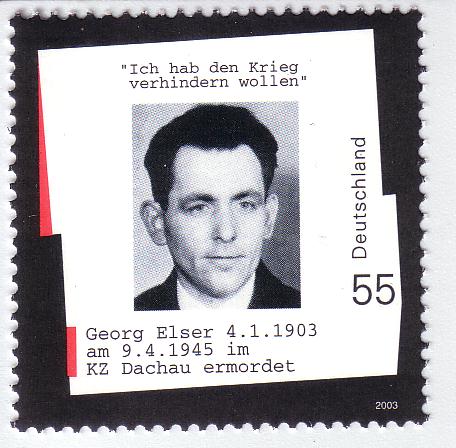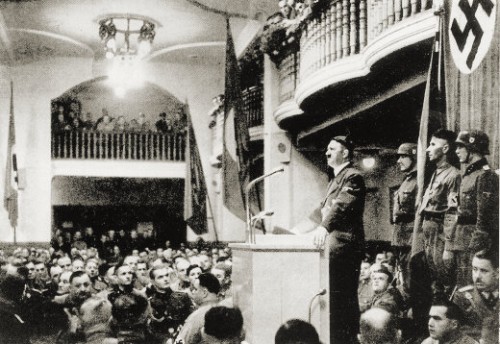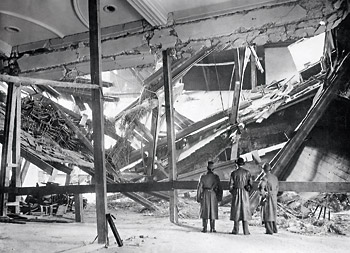One Man Against Tyranny
/https://tf-cmsv2-smithsonianmag-media.s3.amazonaws.com/filer/20110818111011munich-beer-hall-bomb.jpg)
Maria Strobel could not believe it of her Führer. Adolf Hitler and his party—a group of senior Nazis that included Heinrich Himmler, Joseph Goebbels and Reinhard Heydrich—had spent more than an hour in her Munich bierkeller. Hitler had delivered a trademark speech, and, while they listened, Himmler and the others had run up a large beer bill. But the whole group had left in a hurry—leaving the tab unpaid and Strobel untippped.
Much annoyed, the Bavarian waitress set about clearing up the mess. She had made only a small dent in the pile of steins when, at 9:20 p.m. precisely, there was a huge explosion only a few feet behind her. A stone pillar disintegrated in the blast, bringing part of the ceiling crashing down in a rain of wood and masonry. The explosion hurled Strobel the length of the hall and out through the bierkeller’s doors. Though stunned, she survived—the person closest to the blast to do so. Eight others were not so fortunate, and a further 63 were so badly injured that they had to be helped out into the open air. As they staggered toward safety, the dais where Hitler had been standing eight minutes earlier lay crushed beneath six feet of heavy timber, bricks and rubble.

Georg Elser, whose attempt to kill Hitler came within moments of succeeding, commemorated on a stamp. The German phrase means "I wanted to prevent war." Image: Wikicommons
Hitler always said he had “the luck of the devil,” and during his years in power he survived more than 40 plots to kill him. The most famous of these culminated in July 1944, when Claus von Stauffenberg managed to place a bomb inside the conference room in Hitler’s East Prussian headquarters, the Wolf’s Lair. On that occasion, a table support absorbed most of the blast and the Führer survived to hobble out, his eardrums shattered and his trousers torn to ribbons.
That attempt on Hitler’s life is famous—it was the basis for Valkyrie, the 2008 Tom Cruise film—but it can be argued that it was considerably less astounding, and less courageous, than the bierkeller bombing five years earlier. For one thing, Stauffenberg was well-equipped; he really should have done better with the resources at his disposal. For another, he and his fellow plotters were not convinced anti-Nazis; they may have had an aristocratic disdain for their plebian leader, but their primary reason for wanting Hitler dead was not horror at the barbarism of his regime, but simple conviction that he was leading Germany into the abyss.
The Munich bomb, on the other hand, exploded on November 8, 1939, at the height of the Führer’s popularity and less than three months after the outbreak of World War II—before the final order was given for the invasion of France, and when Russia remained a German ally and the United States remained at peace. Not only that; this bomb was the work of just one man, an unassuming carpenter who was far more principled than Stauffenberg and whose skill, patience and determination make him altogether much more interesting. Yet the Munich incident has been almost forgotten; as late as 1998 there was no memorial, in Germany or anywhere else, to the attempt or to the man who made it.
His name was Georg Elser, and this is his story.
Born in 1903, Elser was just below average height and just above average intelligence. He was not much of a thinker, but clever with his hands: an expert cabinetmaker who never read books, rarely touched newspapers and had little interest in politics. He had voted Communist, and briefly joined the Red Front Fighters’ League—streetfighters who took on their Nazi counterparts, the Brownshirts. But Elser was no Marxist, just a typical member of the German working class in the 1930s. He certainly wasn’t a brawler; for him, the attraction of the Fighters’ League was the chance to play in its brass band. In 1939, the only organization that he belonged to was the Woodworkers’ Union.
Beneath this unremarkable exterior, however, Elser did care—mostly about the way the Nazis and their policies were reducing ordinary Germans’ standard of living. The “economic miracle” that Hitler often boasted of had been achieved at considerable cost. Working hours were long and holidays few. Trade unions and political parties were dissolved or banned; wages were frozen. Meanwhile, members of the Nazi party enjoyed privileges not available to those who refused to join. Elser, who was noted as a perfectionist who took infinite care over his work, found it increasingly hard to make ends meet as real wages declined. Asked later to explain his decision to take on Hitler, he was blunt: “I considered that the situation in Germany could only be changed by the elimination of the current leadership.”
There were only a few signs that Elser might be prepared to take his opposition to Nazi regime beyond the crude jokes and grumbles that his handful of friends indulged in. He refused to listen to the Führer when he came on the radio; he would not give the Nazi salute. When a pro-Hitler parade passed though his home town of Königsbronn, in southwestern Germany, he ostentatiously turned his back on it and started whistling.
Yet Elser never confided to anyone that his views were hardening. He remained almost entirely solitary: unmarried and estranged from his father. And it was typical of the man that when, early in 1938, he finally concluded that something needed to be done about the Führer, he didn’t look for help.
It was then that Elser displayed his hidden qualities. Other anti-Nazis had wavered for years over where, when and how they might get close enough to Hitler to kill him. Elser took a purely practical approach. The Führer was renowned for his security consciousness; he tended to cancel arrangements or change plans abruptly. To have a chance of getting to him, Elser recognized, he needed to know that Hitler would be in a specific place at a particular time. And there was only one annual certainty in the Nazi leader’s program: each November, he traveled to Munich to speak at an elaborate commemoration of the Beer Hall Putsch, the risible 1923 attempted coup that had set his party on the road to power. Surrounded by thousands of Old Fighters—Nazis whose party membership dated to 1922 or earlier—Hitler would swap stories and reminisce before delivering the sort of lengthy speech calculated to rouse his loyalists to a frenzy.
So it was that in November 1938—10 months before the Germans invaded Poland—Elser took a train to Munich and scouted out the Nazis’ celebrations. He visited the beer hall where the putsch had started. Known as the Bürgerbräukeller in 1923 but as the Löwenbräu by 1939, it was a cavernous underground hall, capable of holding more than 3,000 revelers and selected by Hitler as the perfect site for a centerpiece speech. Elser attended the festivities, took note of the cellar’s layout, and was surprised to realize that security was lax. In a typical piece of Nazi fudge, two groups were at loggerheads over which was responsible for the Führer’s safety; Hitler opted for his National Socialist German Workers’ Party over the Munich police, which put Christian Weber in charge of security. But Weber, a fat and corrupt former nightclub bouncer, was not much minded to take the sort of strenuous precautions that might actually have safeguarded his leader. A convinced Nazi, it simply did not occur to him that others might hate Hitler enough to take drastic action of their own.
While Elser was in the bierkeller he noted the stone pillar just behind the speaker’s dais; it supported a substantial balcony along one wall. His rough calculations suggested that a large bomb placed within the pillar would bring down the balcony and bury both the Führer and a number of his chief supporters. The question was how to conceal a device sufficiently powerful to do the job within a piece of solid stonework.
Here again Elser proved to have precisely the qualities needed for the job. Knowing that he had a year to prepare, he went to work methodically, obtaining a low-paying job in an arms factory and taking whatever opportunities presented themselves to smuggle 110 pounds of high explosives out of the plant. A temporary job in a quarry supplied him with dynamite and a quantity of high-capacity detonators. In the evenings, he returned to his apartment and worked on designs for a sophisticated time bomb.
In April 1939, Elser returned to Munich to carry out a detailed reconnaissance. He made sketches of the beer cellar and took more precise measurements. He also visited the Swiss frontier to work out an escape route, finding a stretch of the border that was not patrolled.
That August, as Hitler stoked up tension with Poland and Europe slipped toward war, Elser moved to Munich and began the final preparations for planting his device. The work involved huge risks and revealed an imaginative side to the bomber’s personality that few who knew him realized he possessed. Taking advantage of the Löwenbräu’s lax security, Elser became a regular customer. Each evening he would take his dinner there, order a beer and wait until closing time. Then he would slip upstairs, hide in a storeroom and emerge after 11:30 to get down to the crucial job of hollowing the pillar.
The work was astonishingly painstaking and slow. Working by flashlight, Elser first neatly cut a hole in some wood cladding; this job alone took him three nights. Next he attacked the pillar itself. The noise of a chisel striking stone echoed so loudly through the empty bierkeller that Elser restricted himself to single blows every few minutes, timing the descent of his hammer to coincide with the passing of a streetcar or the automatic flushing of the urinals. Every fleck of stone and piece of dust had to be swept up to leave no evidence of his work; then the panel he had cut out of the wood had to be seamlessly replaced before Elser made his escape through a side exit early the next morning. The carpenter returned to the bierkeller evening after evening, working on his plan for 35 nights in all. On one occasion he was nearly caught; a waiter found him inside the building as the place was opening and ran to tell the manager. Questioned, Elser insisted he was simply an early customer. He ordered a coffee, drank it in the garden and left unmolested.
It was typical of Elser that he labored to produce the most efficient bomb he could. By modifying a clock, he created a timer that would run for up to 144 hours before activating a lever; that would trigger a system of springs and weights that would launch a steel shuttle into a live rifle round embedded in explosive. Next, Elser added a second timer to act as a fail-safe, then enclosed the whole bomb in a beautifully built box designed to fit precisely into the cavity he had excavated. He minimized the risk of discovery by lining the cavity with cork, which muffled the noise from the bomb’s clock, and then placing a sheet of tinplate inside the wood panel to prevent any bierkeller worker putting up decorations from unknowingly driving a nail into his delicate mechanism. When he was finished, he returned to the bierkeller with the box he’d made and discovered that it was fractionally too big. He took it home, planed it down and went back again to make sure it fit.
Elser’s research had revealed that Hitler always began his speech in the Löwenbräu at about 8:30 p.m., spoke for about 90 minutes, then stayed to mingle with the crowd. On that basis, he set his bomb to explode at 9:20 p.m.—midway, he calculated, through Hitler’s customary tirade.
Finally, having planted the bomb three days before Hitler was due, sealed it in and removed the last traces of his work, Elser returned to Munich two nights later— just 24 hours before Hitler was due to speak. Then, at a time when it was entirely reasonable to suppose that even the inefficient Weber might have stepped up his security a little, he broke back into the bierkeller and pressed his ear against the pillar to check that his device was still ticking.
Had Elser paid closer attention to the newspapers, he might have felt that all his work had been wasted—shortly before Hitler was due to deliver his bierkeller speech, he canceled the arrangement, only to reinstate it the day before he was due to travel. But then, had Elser read the newspapers, he would also have realized that, as a concession to Hitler’s urgent need to be in Berlin, his speech had been rescheduled. It would now begin at 8 p.m. and last for little more than an hour.
In the event, Hitler stopped speaking at 9:07 p.m. precisely. He declined the efforts of the Old Fighters to have him stay for the usual drink, and at 9:12 hurried out of the Löwenbräu and back to the Munich railroad station. Eight minutes later—when Elser’s bomb exploded in a blinding flash, right on time—the Führer was boarding his train with all his retinue and most of the bierkeller crowd had left the building. It was not until the Berlin express halted briefly at Nuremburg that an incredulous Hitler learned how close he had come to death.
By 9:20 Elser, too, was far from the Löwenbräu. That morning he had taken a train for Konstanz, close to the Swiss border, and when darkness fell he set out to walk into Switzerland. But if Hitler’s luck held that night, his would-be assassin’s ran out. Elser’s April reconnaissance had taken place in peacetime; now, with Germany at war, the border had been closed. He was arrested by a patrol as he sought a way through wire entanglements. Told to turn out his pockets, he quickly found himself in trouble. Perhaps hoping to persuade the Swiss authorities of his anti-Nazi credentials, he was carrying with him sketches of his bomb design, a fuse, his Communist party membership card, and a picture postcard of the Löwenbräu—an incriminating collection of possessions at the best of times, and worse when, minutes later, an urgent telegram arrived with news from the bierkeller.
Elser was taken back to Munich for interrogation. Hitler himself took a close interest in the bomber, asking to see his file and commenting favorably on his “intelligent eyes, high forehead and determined expression.” But for Hitler, the sophistication of the plot was evidence that the British Secret Service was behind it. “What idiot conducted this investigation?” he demanded when told that Elser claimed to have worked alone.
The bomber was subjected to beatings, hypnosis and torture in an attempt to get at Hitler’s truth; he stuck to his story, and even reproduced a version of his bomb to show the Gestapo he had built it. Eventually, the historian Roger Moorhouse relates, Himmler himself arrived in Munich to continue the interrogation:
“With wild curses, drove his boots hard into the body of the handcuffed Elser. He then had him … taken to a lavatory … where he was beaten with a whip or some similar instrument until he howled with pain. He was then brought back at the double to Himmler, who once more kicked and cursed him.”
Through all this, the carpenter stuck to his story, and eventually the Gestapo gave up and packed him off to Sachsenhausen, a concentration camp. Strange to say, Elser was not executed or even badly treated there; although held in solitary confinement, he was allowed a bench and his tools, and kept alive until the last month of the war. It is generally supposed that Hitler wanted him alive to star in a war crimes trial in which he would have implicated the British in the Munich plot.
There are those who say that the Nazis were too efficient to allow a lone bomber to hurt them in this way, and that the whole affair had been stage-managed to provide Hitler with an excuse to clamp down further on the left. Martin Niemöller, a Protestant pastor held at the same camp as Elser, would later testify that he had heard this story on the prisoners’ grapevine; Elser himself is supposed to have confessed to it. But now that we have the transcripts of the interrogation, and better understand the inefficient and chaotic way that Hitler ran the Nazi state, this theory no longer rings true. The Nazis, in wartime, needed no reason or excuse to stamp out resistance. Today, historians accept that the attempt on the Führer’s life was serious, and that Elser acted alone.
There remains the vexing question of how, or whether, Elser’s life should be celebrated. Can an act of terrorism ever be justified, even when its purpose is to kill a murderous dictator? Might the innocent lives the bomber took in the Löwenbräu have been balanced by those that could have been saved had Hitler died before the war was fully underway?
Himmler, for one, had no desire to wait for those questions to be answered. In April 1945, as the Americans, British and Russians closed in, he had Elser taken from his cell and shot. A week later, the death was reported in the German press, blamed on an Allied air raid.
In the frantic last days of the Thousand Year Reich, few would have noticed the announcement. And six years and more than 60 million deaths later, fewer still would have recalled the name of Georg Elser.
Sources
Michael Balfour. Withstanding Hitler in Germany 1933-45. London: Routledge, 1988; Martyn Housden. Resistance and Conformity in the Third Reich. London: Routledge, 1997; Ian Kershaw. Hitler: Nemesis, 1936-1945. London: Penguin, 2000; Roger Moorhouse. Killing Hitler: The Third Reich and the Plots Against the Führer. London: Jonathan Cape, 2006.
/https://tf-cmsv2-smithsonianmag-media.s3.amazonaws.com/accounts/headshot/mike-dash-240.jpg)




/https://tf-cmsv2-smithsonianmag-media.s3.amazonaws.com/accounts/headshot/mike-dash-240.jpg)